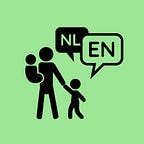Dyslexia
On this page I will talk about dyslexia and what this means for bilingualism or when learning another language. As this is not one of the usual topics within speech therapy, I have no professional experience with it. My husband does have dyslexia though, and through him I’ve gained some perspective to what it means for someone to have it. His dyslexia and struggles to learn new languages has also been one of the main reasons of why we raise our own children bilingually.
What is dyslexia?
Dyslexia is a learning difficulty that mainly causes problems in reading, writing, and spelling. Because of this, it’s also known as a reading disorder. Dyslexia can be passed down through genetics, but doesn’t have to. People with developmental language disorders also have a higher risk of having dyslexia. Dyslexia however, is not a language problem itself. The main problem in dyslexia is coding and decoding. Both have to do with the ability to link a sound to a letter, and therefor eventually spoken words to written words. Coding (spelling) is linking sounds to letters, and decoding (reading) is combining written letters to a spoken word. Children with dyslexia start showing problems only after learning how to read and write (mostly on school), and some of the problems are: reading very slowly, lots of spelling mistakes, problems with understanding texts. Some children with dyslexia might have difficulty with their auditory skills before they start to learning to read and write. Auditory skills include hearing separate sounds withing a word and rhyming.
Further risks of dyslexia
Dyslexia is not a language disorder, it can however cause extra (language) difficulties in developing children. As children get older, reading becomes an increasingly bigger part of language development. Especially at schools, subjects are taught not only verbally but also in textbooks and similar media. When having difficulty with reading, all skills and that rely on reading will be in danger. In language development this often means a much smaller vocabulary, both receptive and active.
Dyslexia and young bilinguals
When a young bilingual has dyslexia, this will be present in all their languages. It’s not possible to have dyslexia in only one of the languages. However, it is possible that the perceived problems are different or less/more severe in one of the languages. This often has to do with how transparent the languages are, and which writing system is used. Children will have problems in writing and reading all their languages, but will not be restricted in learning the actual languages themselves.
Writing systems
In alphabetical languages (Cyrillic, Greek, Hebrew, Latin), one symbol (the letter) corresponds to a single sound. Some languages are very transparent and always have the same letter-sound link. Others don’t and have multiple possible letter-sound links or write combinations of letters that are not spoken out loud (e.g. English is not very transparent with words like “knife” and “though”, while Italian is much more transparent).
Other languages use different systems such as logographic systems that use a single symbol for a complete grammatical word (such as Chinese characters and Hieroglyphs). A syllabic system uses a single symbol for a syllable, using a few symbols for a full word (such as Japanese and Cherokee). An Abjad and an abugida are systems that are in between the syllabic and alphabetical systems, using only consonants with Abjad (such as Arabic) and mainly consonants with Abugida (such as Indic and Ethiopic). In all these different systems, it’s still the same skill that’s needed to link sounds to symbols, and will all be affected by dyslexia.
Dyslexia and language learning
Most languages that are learned at a later stage in life, are actively learned instead of acquired. This learning often includes classes with textbooks and therefor requires reading and writing. Individuals with dyslexia can have more difficulty with learning languages than individuals without dyslexia. The more spoken language and immersion is used, the easier the learning of the language is done. Many adults also wish or need to read and write in their new language however, so this can be a challenge.
Practical tips
While researching this topic, I came across much more information than I’m including in this post. Some practical tips however, I’ll add below because I thought they were nice to share.
Did you know that there is a dyslexia font? As many letters in the latin alfabet look similar (bdpq for example), a font is creating especially for dyslexic people. It’s supposed to read more easily once you get used to it. (Curious? More information about it is on their website, dyslexiefont.com)
As dyslexia is a problem with reading and writing, diagnoses is often a bit later in childhood. If problems in language or specifically auditory skills are seen, especially when dyslexia is seen in the immediate family, it might be good to find help early. Speech therapist normally don’t treat dyslexia in an ordinary practice, but they can help with strenghting auditory skills.
Originally published at https://www.nimke.nl.
